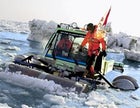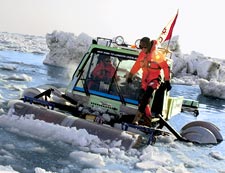SCHOLARS GENERALLY AGREE that the earliest North Americans crossed over from Asia via the Bering Land Bridge—an Ice Age isthmus that linked the two continents about 11,000 years ago. This month, Steve Brooks and his partner, Graham Stratford, plan to head the other way, traversing what is now a 60-mile expanse of shifting ice aboard a contraption that once groomed bunny slopes in Ontario. Their goal? An adventure prize that is part Mallory, part Magoo: to become the first humans to drive across the Bering Strait.
Ice Challenger Coverage
UPDATE: Russian Red Tape Stops Ice Challenger Half Way ()Watch an ���ϳԹ��� Television special on Ice Challenger, June 5 at 9 P.M. Eastern/Pacific on the Outdoor Life Network
Expedition report and photos in the July issue of ���ϳԹ���
 The Ice Challenger team on a practice run off Wales, Alaska
The Ice Challenger team on a practice run off Wales, Alaska
It remains to be seen whether the $1 million project, dubbed Ice Challenger, represents a milestone of exploration or merely an expensive lark, but these guys aren’t kidding around. Brooks is a wealthy 41-year-old London real estate developer who bankrolled five years of research and as many prototypes; Stratford, 40, designs expedition vehicles out of his office in Hereford, England. Together they’ve created Snowbird 6, a seven-ton ski-slope-grooming machine that they’ve rejiggered into a kind of high-Arctic monster truck. On solid ice, the neon-green beast plods along on caterpillar tracks at ten miles per hour. Upon reaching a stretch of slush or open sea, Brooks and Stratford pull a lever, lower a pair of five-foot-diameter revolving pontoons, and drive right in. The hollow aluminum outriggers provide both propulsion—picture a pair of side-mounted corkscrew propellers—and, as they lift the vehicle and crew safely clear of the water, flotation.
Clever stuff, but one has to wonder, What’s the point? “I wanted to push beyond my normal boundaries,” says Brooks, who says the expedition is neither charity event nor marketing stunt, but rather a simple kick. “I learn so much about myself that way.”
The Journey to the Center of Steve will begin when a rented Hercules transport plane deposits him, Stratford, and Snowbird 6 in Nome, Alaska. From there, they’ll drive 160 miles north and establish base camp in the tiny Inuit village of Wales. After topping off the antifreeze, they’ll steer west, bound for the two-square-mile island of Little Diomede, 20 miles into the Strait, where they hope to stop for the night. Alarmingly, at that time of year, Little Diomede tends to shrug off large chunks of its glaciers, which could easily turn even the beefiest snowcat into tinfoil. So if things look dicey, Brooks and Stratford won’t stop at all—instead they’ll push on to Lavrentia, Russia, completing the journey in three days straight.
As one might guess, the locals think the Brits are nuts. “You could say they are in for a wild ride on 15-foot ice cubes,” says David Carraway, a U.S. Coast Guard chief based in Port Clarence, Alaska, about 60 miles south of Wales. He reels off a litany of dangers: drifting house-size bergs, hungry polar bears, windchills dipping to minus 94 Fahrenheit, and (if the pontoons fail) the chance of a plunge into 28-degree water that would kill Brooks and Stratford with cold before they have a chance to drown. The last time someone tried tackling these hazards in a vehicle, the elements prevailed. As part of a 1993 effort to travel overland from London to New York, BBC producer Richard Creasey abandoned an ice-rescue machine called Arktos on the Russian side of the crossing, its jet-propulsion tubes hopelessly clogged with slush.
After a series of promising field tests last March in Alaska, Brooks believes his machine will fare better than Creasey’s. Should he and Stratford conquer the strait, they hope to repeat the trick as part of a 2003 bid to drive around the world. If stubbornness counts for anything, Brooks is halfway home.
“We’re not coming to this believing we’re the world’s greatest explorers,” he says. “But we might be among the most persistent.”


